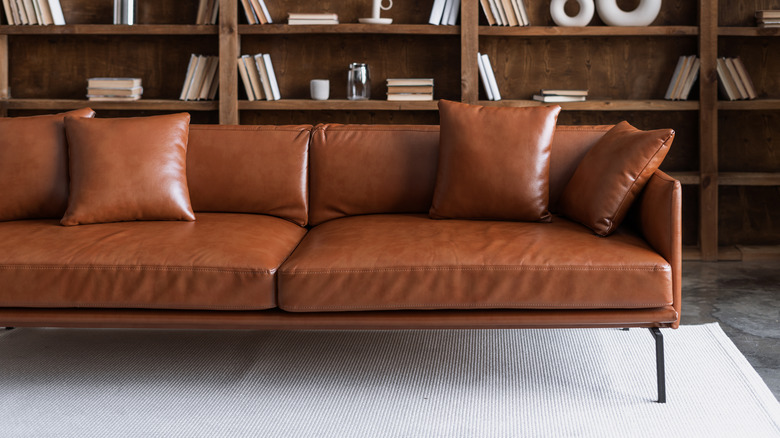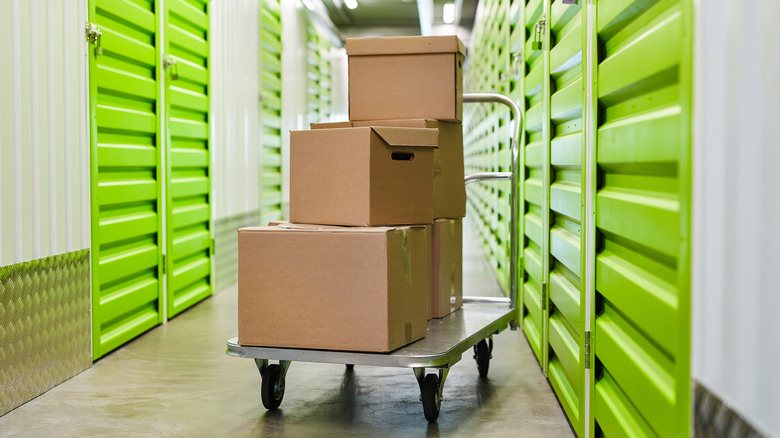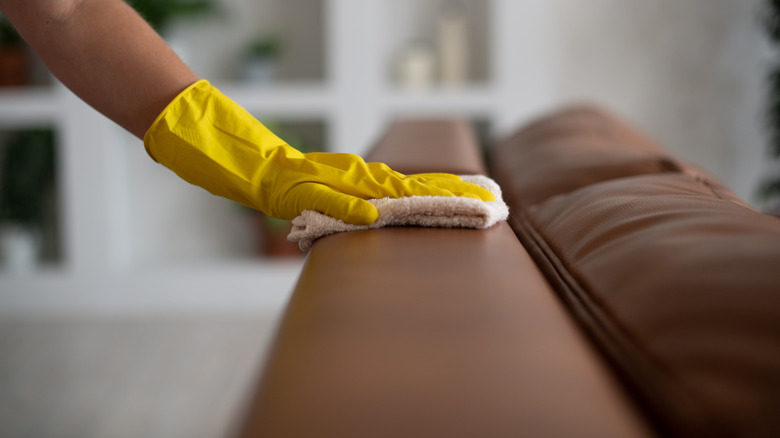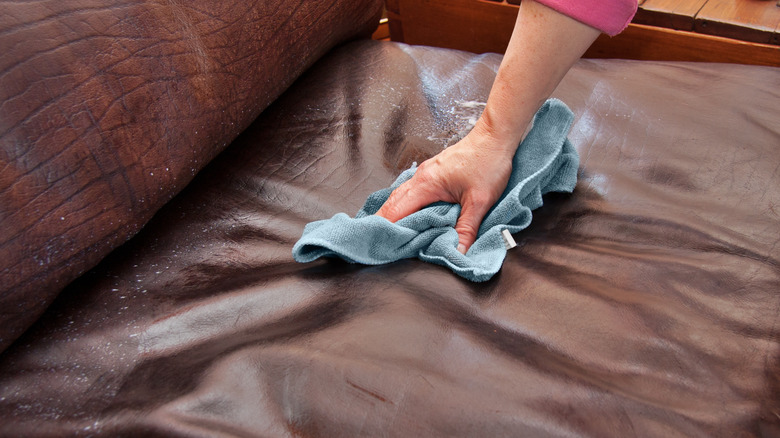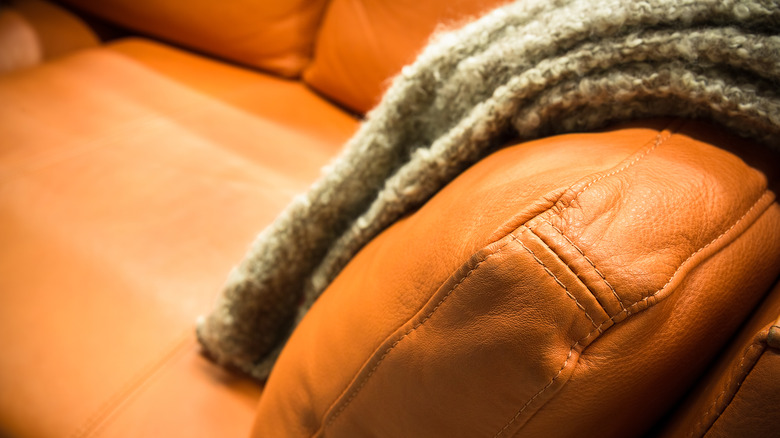How To Prepare Your Leather Couch For Storage
Leather is a widely used material for a reason. It's sturdy, breaks in organically over time, and adds a warm, fashionable twist to any room. When it comes time to store it away, however, dealing with a natural material can be a bit of a hassle. Leather requires special upkeep to protect it from discoloring, fading, and losing its integrity, so there are a few special steps you should take before simply placing it in a storage unit (via Sofas by Saxon). Still, with a little TLC, it's one of the sturdiest materials you can choose for your furniture.
Whether you're moving, downsizing, or just changing up your home's look, there are ways to ensure that your leather furniture goes unscathed and maintains its quality so it's ready to go when it comes time to bring it back into your space. Keep reading to learn how, and avoid the cost of an expensive restoration or brand-new sofa down the line.
Choose a climate-controlled storage unit
Before you even plan to move your furniture, look into the type of storage units available in your area. If possible, choose something that's climate-controlled, as it can significantly affect how well your leather furniture holds up. While this might be more expensive, it can help protect your furniture pieces from heat and moisture that can deteriorate the material and save you quite a bit of money in the long run.
Leather is best stored at 65 degrees Fahrenheit to 70 degrees Fahrenheit in areas with low humidity and away from direct sunlight. According to Leathercraft Toolbox, staying in this temperature range can help stop the evaporation of oils that keep the leather supple, making sure the humidity is low, preventing the formation of mold and mildew, and keeping the furniture out of the sun prevents fading and excess heat. If you don't have the option to control the temperature, leather still lasts well in a colder environment as long as it doesn't freeze.
Clean all leather surfaces
While it may seem waterproof, leather is a porous material. So cleaning your couch, chairs, and stools made of this fabric can help prevent crumbs from scratching the surface or stains from soaking in and causing unpleasant smells later on. This is especially important for couches and chairs with deep cracks or cushions — you want to ensure all those loose popcorn kernels from movie night are completely cleaned out.
The easiest way to do this is to thoroughly vacuum your furniture, ensuring you get in deep, and remove any cushions if possible. From there, MasterClass recommends using a store-bought leather cleaner or warm water to gently wipe everything down. Don't go too heavy-handed with this — a little dampness is fine, but completely soaking your sofa is a recipe for mold and mildew down the line. From there, allow the piece to dry out fully before bringing it to your storage unit and packing it away.
Condition the leather
If you've had your leather furniture for a while, you already know how important conditioning is. A coat of oil or wax keeps the material supple and moisturized and prevents any cracking. In addition, it will naturally dry out over time, so conditioning right before you store your pieces will ensure they're still in good shape when you decide to use them again.
According to Galen Leather Co., you should start by testing a small patch of your furniture to make sure the conditioner doesn't change your piece's color. Wait 24 hours, and if there are no issues, you can continue to the rest of the material. Next, rub the conditioner in with a soft cloth like microfiber, wait for it to absorb, and wipe away any excess. If it doesn't come out shiny, don't be alarmed. Leather should fully absorb the conditioner, so the finish may come out more matte depending on your product or if it's been a while since you've last conditioned it. If the material feels supple instead of dry and stiff, you're good to go.
Cover the furniture to protect it
Blankets will be your best friend when it comes to moving and storing your leather pieces. Wrapping them up in a moving or cotton blanket is a great way to prevent dust and grime while in storage, but it also helps protect them from scratches and nicks during transport. Because of this, it's best to wrap up your furniture while it's still at home, Elite Moving & Storage recommends.
Choosing something that's breathable and soft is your best bet to get a solid amount of protection without encouraging the growth of mildew or mold, so it's a good idea to avoid plastic covers that don't encourage airflow. To properly wrap everything, disassemble whatever you can of the piece, then tackle individual parts, especially if you're dealing with a sectional. From there, completely cover your furniture with the blankets, making sure to protect the bottom and back as well, then secure everything with packing tape.
Properly pack your storage unit
Once you get to your storage unit, make sure everything is clean. Sweep out debris, tackle any cobwebs, and brush away dust. Adding a layer of plastic on the floor can also help, as it prevents any scratches on your furniture's legs from rough concrete and acts as a barrier to moisture. After setting up the area, ensure your pieces are placed with a little wiggle room away from the wall. Too close, and the leather doesn't have the chance to breathe properly.
When you're filling the rest of the unit, be mindful of the items you place around and on top of your furniture. Light, soft things like pillows and blankets can rest atop of your furniture without issues, but heavier items can cause dents in the material over time. If you find that the leather has creases or indentation marks when you pull it from the unit, however, these can easily be smoothed out with a heat gun or hair dryer (via Colourlock Australia). Taking all of these steps to protect your furniture might seem a bit like overkill, but they can save you a lot more effort and money down the line.
